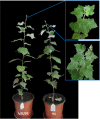Effect of Overexpression of JERFs on Intracellular K+/Na+ Balance in Transgenic Poplar (Populus alba × P. berolinensis) Under Salt Stress
- PMID: 32922413
- PMCID: PMC7456863
- DOI: 10.3389/fpls.2020.01192
Effect of Overexpression of JERFs on Intracellular K+/Na+ Balance in Transgenic Poplar (Populus alba × P. berolinensis) Under Salt Stress
Abstract
Salt stress is one of the main factors that affect both growth and development of plants. Maintaining K+/Na+ balance in the cytoplasm is important for metabolism as well as salt resistance in plants. In the present study, we monitored the growth (height and diameter) of transgenic Populus alba × P. berolinensis trees (ABJ01) carrying JERF36s gene (a tomato jasmonic/ethylene responsive factors gene) over 4 years, which showed faster growth and significant salt tolerance compared with non-transgenic poplar trees (9#). The expression of NHX1 and SOS1 genes that encode Na+/H+ antiporters in the vacuole and plasma membranes was measured in leaves under NaCl stress. Non-invasive micro-test techniques (NMT) were used to analyse ion flux of Na+, K+, and H+ in the root tip of seedlings under treatment with100 mM NaCl for 7, 15, and 30 days. Results showed that the expression of NHX1 and SOS1 was much higher in ABJ01 compared with 9#, and the Na+ efflux and H+ influx fluxes of root were remarkable higher in ABJ01 than in 9#, but K+ efflux exhibited lower level. All above suggest that salt stress induces NHX1 and SOS1 to a greater expression level in ABJ01, resulting in the accumulation of Na+/H+ antiporter to better maintain K+/Na+ balance in the cytoplasm of this enhanced salt resistant variety. This may help us to better understand the mechanism of transgenic poplars with improving salt tolerance by overexpressing JERF36s and could provide a basis for future breeding programs aimed at improving salt resistance in transgenic poplar.
Keywords: JERF36s; NHX1; SOS1; ion balance; poplar; salt resistance.
Copyright © 2020 Ding, Zhang, Li, Dong, Liu, Huang and Su.
Figures









References
-
- Barragán V., Leidi E. O., Andrés Z., Rubio L., De Luca A., Fernández J. A., et al. (2012). Ion exchangers NHX1 and NHX2 mediate active potassium uptake into vacuoles to regulate cell turgor and stomatal function in Arabidopsis. Plant Cell 24 (3), 1127–1142. 10.1105/tpc.111.095273 - DOI - PMC - PubMed
LinkOut - more resources
Full Text Sources
Miscellaneous

